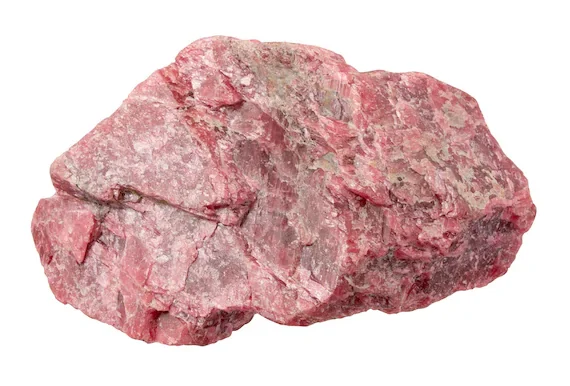
Appearance
Rhodonite is distinguished by its unique color, which ranges from light pink to a deep rose-red. Additionally, certain examples could have gray, black, or brown tones. Manganese impurities are principally responsible for the color of rhodonite. The triclinic crystal system, which has three uneven axes and non-90 degree angles, is the crystallographic system in which rhodonite forms. When polished, rhodonite usually has a translucent to somewhat pearly luster. Rhodonite’s polished surface has a reflective, glossy appearance that adds to its visual appeal.
Geographical Distribution
The main locations for rhodonite are those connected to deposits rich in manganese. It happens in many different countries across the world, but major cases have been reported in the US, Canada, Australia, Sweden, Peru, Russia, and Sweden.
It is significant to remember that rhodonite is also present in smaller amounts in other nations, including Kazakhstan, South Africa, Mexico, Argentina, and Brazil.
History
It was initially found in the Ural Mountains, close to Sidelnikova, in 1790. German naturalist Christoph Friedrich Jasche gave the stone the name rhodonite in 1819; the word comes from the Greek word “rhodo,” which means “rose.” Rhodonite deposits, despite their name, can be pink, brownish, or purple-red in hue.
Metaphysical Properties
Rhodonite might help you in achieving harmony between your physical and mental energies.

Chemical Composition
The silicate mineral rhodonite is a member of the pyroxene group. Its chemical formula, (Mn,Fe,Mg,Ca)SiO_3, usually indicates that manganese (Mn) makes up the majority of its composition, with varying proportions of iron (Fe), magnesium (Mg), and calcium (Ca). The color and features of the gemstone may also be influenced by trace levels of other elements.
Types
Here are a few notable rhodonite hues and varieties:
Pink Rhodonite:
The most prevalent hue of rhodonite is a delicate, rosy pink. There are many variations in this shade of pink, from light and delicate to bright and vivid.
Red Rhodonite:
Additionally, rhodonite can be found in deeper red tones that resemble burgundy or scarlet. When it comes to Rhodonite specimens, these deep red tones are quite valuable and in high demand.
Black Veined Rhodonite:
Several Rhodonite specimens have noticeable manganese oxide inclusions or black veins. The dark veins in the gemstone provide visual interest by creating dramatic patterns against the pink or red background.
Manganese-rich Rhodonite:
Higher manganese concentrations in certain Rhodonite specimens can give them a darker, nearly black color. These types, which are high in manganese, might have black veining and deep or brownish red colors.
Gray and Brown Rhodonite:
Rhodonite is most frequently found in pink and red, however it is also infrequently seen in gray or brown tones. Even though they are less prevalent, these earthy tones can nevertheless have visually appealing textures and patterns.
Uses
- Jewelry: Rhodonite is a gemstone that is extremely valuable and frequently used in jewelry. Its durable nature and appealing pink to red hue make it appropriate for a variety of jewelry pieces, such as pendants, earrings, necklaces, bracelets, and rings. The designs of rhodonite jewelry can be delicate and feminine or strong and statement-making.
- Carvings and Sculptures: Rhodonite is an excellent material for carving and sculpting into beautiful sculptures because of its toughness and pleasing color. Expert craftspeople frequently use rhodonite to craft elaborate figurines, beads, cabochons, and decorative sculptures. You can use these carved Rhodonite pieces as personal talismans, home decor, or collectors.
- Tumbled Stones and Polished Pebbles: Rhodonite is commonly polished and tumbled to create spherical, smooth stones or pebbles. Because of its healing qualities, tumbling Rhodonite stones are well-liked in the metaphysical community and are frequently utilized in energy work, crystal healing, and meditation.
- Beads and Cabochons: Rhodonite is a popular choice for beads and cabochons in jewelry manufacturing because of its vivid color and eye-catching patterns. While cabochons are employed as focal pieces in rings or pendant settings, rhodonite beads can be incorporated into bracelets, earrings, and necklaces.
- Decorative Objects: Rhodonite can be used for ornamental items other than jewelry because of its beauty and unique appearance. It is employed in the creation of ornamental bowls, vases, bookends, and other objects. These Rhodonite ornaments can give interior design a dash of refinement and organic charm.
Table





